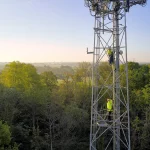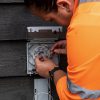OneWeb May Test Removal Service on Failed Broadband Satellite UPDATE

British-registered satellite operator OneWeb, which is partly owned by the UK government and aims to build a new global network of low latency ultrafast broadband satellites in Low Earth Orbit (LEO), is considering the possibility of testing a new debris-removal service to deorbit one of their failed spacecraft (SL41).
At present OneWeb has launched a total of 358 small c.150kg Low Earth Orbit (LEO) ultrafast broadband satellites into space (orbiting at around 1,200km) and their initial plan is to build a constellation of 648, which is enough for a reasonable level of global coverage by around June 2022 (a beta service is due to launch before the end of this year).
The operator actually only needs 588 satellites to achieve global coverage, but the reason for the additional platforms is to help provide some redundancy protection against failures (i.e. the extra 50-60 satellites are essentially spares). Such LEOs are only intended to stay aloft for a few years and eventually their fuel will run out, at which point they can be automatically de-orbited.
Advertisement
However, the automatic method only works if the satellite is operational, which might not be the case if it suffers a more fundamental system failure. In those cases, it could be many years before the craft deorbits naturally, during which time it will add to the ever-growing list of “space junk” hazards that encircle the earth, causing problems for other satellites and space missions. Starlink has less of a problem here because they sit at a lower orbit and failed craft will thus come down within c.5 years due to atmospheric drag.
The good news is that OneWeb has so far only had a single LEO satellite fail (SL41) following a “software issue“, which compares favourably with SpaceX’s rival Starlink service that has launched a total of 1844 LEOs so far (orbiting at around 500km), including 25 early deorbits, 97 disposals and 6 that suffered reentry after failure.
Debris-Removal Service
The alternative to an automatic or natural deorbit is the somewhat experimental idea of a debris-removal service. On this front, OneWeb has previously signed a £2.5m partnership with Astroscale in May 2021, which is part of ESA’s Sunrise program. The goal of that is to develop and demonstrate various new technologies, including space junk removal.
In simple terms, this involves the deployment of a special spacecraft (ELSA-M Servicer) that travels to the failed satellite, locks on and then helps to pull it back down for a more rapid deorbit. The same ELSA-M Servicer could then rise up and repeat this task as and when other satellites fail.
Advertisement

The UK Space Agency has previously also awarded Astroscale and Swiss startup ClearSpace contracts to study a mission that aims to remove two spacecraft from LEO by 2025. According to a spokesperson for OneWeb (Spacenews): “We are working with ESA Sunrise and, by extension, Astroscale and others to determine how best to remove a failed satellite when technology permits. It’s very early days.”
As we say, this is currently all very experimental, but OneWeb’s SL41 does indeed look like a prime test candidate for one of these future missions. If successful, then such technologies could be used to help slowly clear Earth orbit of a much larger collection of space junk. The downside is that such missions will attract a high cost, thus ensuring the re-usability of the servicer will be essential to keep costs under control.
UPDATE 27th May 2022
Advertisement
OneWeb, Astroscale, and the UK and European Space Agencies have partnered up to launch the space junk servicer ELSA-M with a €14.8 million investment. The ELSA-M servicer will launch towards the end of 2024.
Mark is a professional technology writer, IT consultant and computer engineer from Dorset (England), he also founded ISPreview in 1999 and enjoys analysing the latest telecoms and broadband developments. Find me on X (Twitter), Mastodon, Facebook, BlueSky, Threads.net and Linkedin.
« Broadband ISP File Sanctuary Discounts FTTP Packages by GBP6
ISP Telcom Group Launch Fibre Engineer Training Programme »






















































Space junk removal eh. I guess where there’s a need, someone will figure out a way to provide a service
That’s actually quite a neat use of Newton’s Third Law, if that’s what they’re doing here: push the junk down, thereby propelling the Servicer back up.